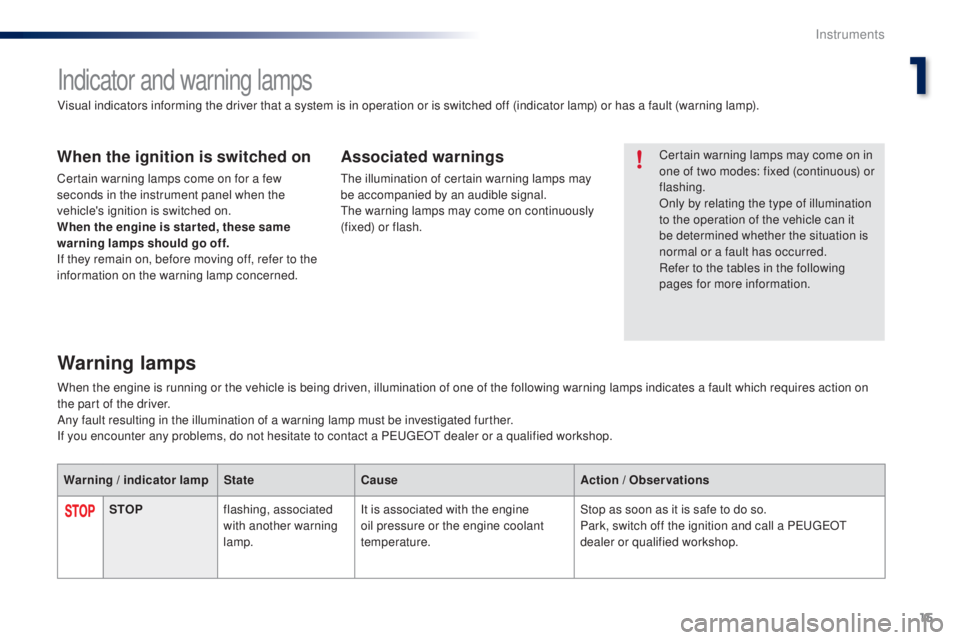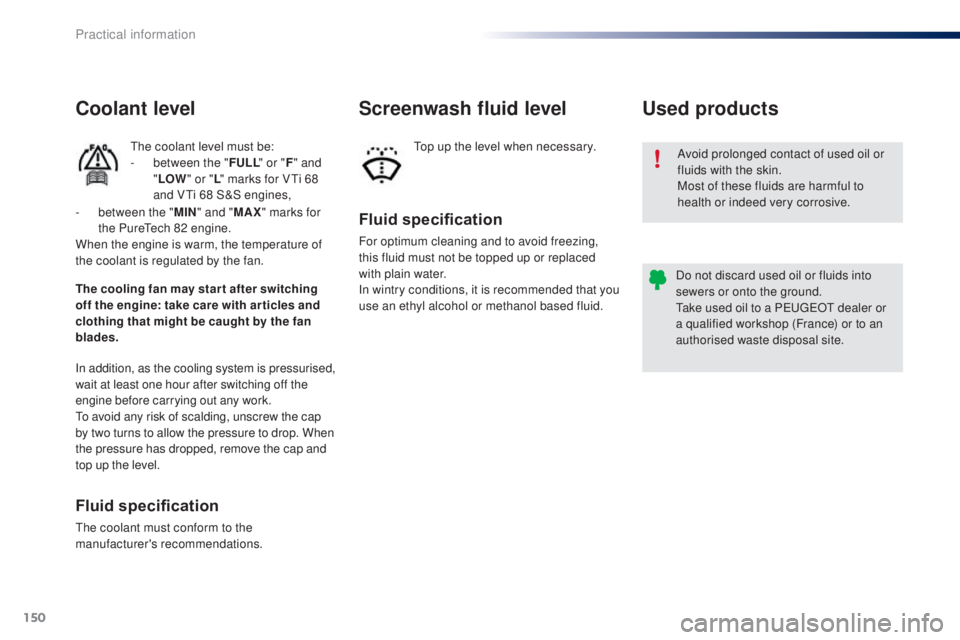2016 PEUGEOT 108 low oil pressure
[x] Cancel search: low oil pressurePage 12 of 268

10
108_en_Chap00c_eco-conduite_ed01-2016
Limit the causes of excess consumption
Spread loads throughout the vehicle; place the heaviest items in the
bottom of the boot, as close as possible to the rear seats.
Limit the loads carried in the vehicle and reduce wind resistance
(roof bars, roof rack...). u
s
e a roof box in preference.
Remove roof bars and roof racks after use.
At the end of winter, remove snow tyres and refit your summer tyres.
observe the recommendations on
maintenance
Check the tyre pressures regularly, when cold, referring to the label in
the door aperture, driver's side.
Carry out this check in particular:
-
b
efore a long journey,
-
a
t each change of season,
-
a
fter a long period out of use.
Don't forget the spare wheel and the tyres on any trailer or caravan.
Have your vehicle serviced regularly (engine oil, oil filter, air filter,
passenger compartment filter...) and observe the schedule of
operations recommended in the warranty and maintenance record.
When refuelling, do not continue after the third cut-off of the nozzle to
avoid any over flow.
At the wheel of your new vehicle, it is only after the first 1 800 miles
(3
000 kilometres) that you will see the fuel consumption settle down to
a consistent average.
eco-driving
Page 17 of 268

15
108 _en_Chap01_instrument- de-bord_ed01-2016
Indicator and warning lamps
Certain warning lamps may come on in
one of two modes: fixed (continuous) or
flashing.
Only by relating the type of illumination
to the operation of the vehicle can it
be determined whether the situation is
normal or a fault has occurred.
Refer to the tables in the following
pages for more information.
Visual indicators informing the driver that a system is in operation or is switched off (indicator lamp) or has a fault (warning lamp).When the ignition is switched on
Certain warning lamps come on for a few
seconds in the instrument panel when the
vehicle's ignition is switched on.
When the engine is star ted, these same
warning lamps should go off.
If they remain on, before moving off, refer to the
information on the warning lamp concerned.
Associated warnings
the illumination of certain warning lamps may
be accompanied by an audible signal.
th
e warning lamps may come on continuously
(fixed) or flash.
Warning lamps
StoP f lashing, associated
with another warning
lamp. It is associated with the engine
oil pressure or the engine coolant
temperature. Stop as soon as it is safe to do so.
Park, switch off the ignition and call a Pe
ugeOt
dealer or qualified workshop.
When the engine is running or the vehicle is being driven, illumination of one of the following warning lamps indicates a fault which requires action on
the part of the driver.
Any fault resulting in the illumination of a warning lamp must be investigated further.
If you encounter any problems, do not hesitate to contact a P
e
uge
Ot
dealer or a qualified workshop.
Warning / indicator lamp StateCause Action / o
b
servations
1
Instruments
Page 18 of 268

16
Brakingfixed.th e braking system fluid level has
dropped significantly.to p up with brake fluid recommended by Pe ugeOt.
I f the problem persists, have the system checked by a
P
e
uge
Ot
dealer or a qualified workshop.
th
e braking system has a fault. Stop as soon as it is safe to do so.Park, switch off the ignition and contact a P
e
uge
Ot
dealer or a qualified workshop.
Warning / indicator lamp
StateCause Action / o
b
servations
en
gine oil
pressure fixed, associated with
the S
tO
P warning
lamp.
th
e engine oil pressure is too low. Stop as soon it is safe to do so.Park, switch off the ignition and contact a P
e
uge
Ot
dealer or a qualified workshop.
Coolant
temperature flashing (V
ti 6
8
e
ngine
only).
the
temperature of the engine
coolant is increasing. Drive gently.
fixed.
the
temperature of the engine
coolant is too high. Stop as soon as it is safe to do so.
Wait until the engine has cooled down before
checking up the level; top up if necessary.
If the problem persists, contact a P
e
uge
Ot
dealer or
qualified workshop.
Anti-lock
Braking System
(ABS) fixed.
th
e anti-lock braking system has a
fault.
th
e vehicle retains conventional braking.
Drive carefully at reduced speed and contact a
P
e
uge
Ot
dealer or a qualified workshop without
d e l ay.
Instruments
Page 152 of 268

150
108_en_Chap07_info-pratiques_ed01-2016
Avoid prolonged contact of used oil or
fluids with the skin.
Most of these fluids are harmful to
health or indeed very corrosive.
Do not discard used oil or fluids into
sewers or onto the ground.
ta
ke used oil to a P
e
uge
Ot
dealer or
a qualified workshop (France) or to an
authorised waste disposal site.
used products
Fluid specification
For optimum cleaning and to avoid freezing,
this fluid must not be topped up or replaced
with plain water.
In wintry conditions, it is recommended that you
use an ethyl alcohol or methanol based fluid.
Screenwash fluid level
top up the level when necessary.
Coolant level
the coolant level must be:
- b etween the " F
uL L" or " F" and
" L
o
W" o
r "L" marks for V
ti 6
8
and V
ti 6
8 S&S engines,
In addition, as the cooling system is pressurised,
wait at least one hour after switching off the
engine before carrying out any work.
to a
void any risk of scalding, unscrew the cap
by two turns to allow the pressure to drop. When
the pressure has dropped, remove the cap and
top up the level.
Fluid specification
the coolant must conform to the
manufacturer's recommendations.
th
e cooling fan may star t after switching
off the engine: take care with ar ticles and
clothing that might be caught by the fan
blades. -
b
etween the "
MIN" and " MAX" marks for
the Pure
te
ch 82 engine.
When the engine is warm, the temperature of
the coolant is regulated by the fan.
Practical information
Page 157 of 268

155
108_en_Chap08_en-cas-pannes_ed01-2016
F Check that the compressor switch is at the "o" position.
F
u
n
coil fully the electric cable, stowed under
the compressor.
F
C
onnect compressor's plug to the vehicle's
12 V socket.
F
S
witch on the ignition.
ta
ke care, the sealant product is
harmful if swallowed and causes
irritation to the eyes.
Keep this product out of the reach of
children.
th
e use-by date is marked on the
cartridge.
After use, do not discard the
cartridge by the roadside, take it to a
P
e
uge
Ot
dealer or an authorised
waste disposal site.
Don't forget to obtain a new sealant
cartridge, available from a P
e
uge
Ot
dealer or a qualified workshop. If after around 5 to 7 minutes the
pressure is not attained, this indicates
that the tyre is not repairable; contact
a P
e
uge
Ot
dealer or a qualified
workshop for assistance.
F S tart the compressor by placing the switch
at the " I" position and leave it running until
the tyre pressure reaches 2.0 bar.
t
h
e sealant product is injected into the tyre
under pressure; do not disconnect the pipe
from the valve during this operation (risk of
splashing and stains).
8
In the event of a breakdown
Page 259 of 268

257
108_en_Chap11_index-alpha_ed01-2016
Main beam ..............................................98, 16 4
Maintenance ............................................. 9, 148
Manual mode
.................................................. 77
Mat
.................................................................. 66
Menu (touch screen)
....................189, 190, 202,
208, 220
Mirror, rear view
............................................................... 51
Mirrors, door
............................................................... 50
Mirror, vanity
..............................
.....................64
Mode, driving
........................................................... 77Navigation
.....................................................
220
Number plate lamps
...................................... 16
7
Opening the bonnet
...................................... 14
6
Opening the boot
..............................
........
34, 39
Opening the doors
...............................
...........
34
Parcel shelf, rear
............................................. 67
P
arking brake
..........................................76, 152
Passenger compartment filter
.............................................................151
Pedal, clutch.................................................. 151
Port,
u
S
B
.................................6
3, 65, 198, 245
Power steering
................................................18
Pressures, tyres
............................................157
M
N
O
P
Lamp, boot ...................................................... 62
Lamps, front .......................................... 163, 16 4
Lamps, rear
................................................... 166
Lamps, warning and indicator
..................15 -25
Lane Departure Warning System (LDWS)
.....93
Level, brake fluid
........................................... 14
9
Level, engine coolant
.................................... 150
Level, engine oil
...............................
.............148
Levels and checks
................................. 147-150
Lighting
................
.......................................... 16 4
Lighting dimmer
..............................
................27
Lighting, guide-me home
..............................102
Lighting on reminder
..................................... 10 0
Loading
............................................................. 9
Locating your vehicle
...................................... 32
L
ocking/unlocking a door from the inside....... 38
Low fuel level
.................................... 17, 26, 138Mode, easy (automatic mode)
........................
77
Mountings, Isofix ...........................................132
L
Pre-tensioning seat belts ..............................117
Protecting children ................................ 117, 11 9 ,
123 -127
Puncture
........................................................ 153
Radio
..................................................... 19 4, 242
RDS
....................................................... 195, 242
Rear foglamp ......................................... 10 0, 166
Rear quarter panel windows
........................................................ 41
Rear screen (demisting)
..................................61
Recharging the battery
................................. 17
9
Reinitialisation of the under-inflation detection system
........................................... 96
Remote control
.......................................... 3
2, 37
Removing and fitting a fuse
.......................................................... 168
Removing a wheel
........................................ 15 8
Removing the mat
........................................... 66
Replacing bulbs
............................................ 163
Replacing the air filter
...................................151
Replacing the oil filter
................................... 1
51
Replacing the passenger compartment filter
...................................... 151
Replacing wiper blades
......................................................... 14 4
Reversing camera
........................................... 92
Reversing lamps
........................................... 166
Roof bars
....................................................... 14
4
Roof, electric fabric
............................................................. 42
Routine checks
..................................... 151, 152
R
.
Alphabetical index